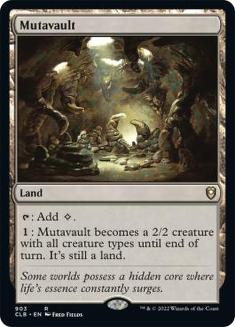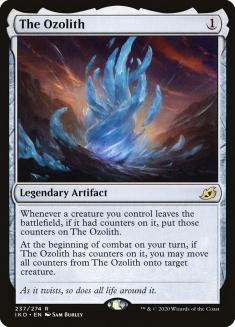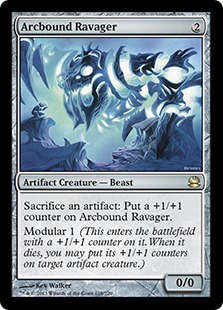In Magic, weeks can feel like years. Pioneer players know that feeling all too well. Announced less than six months ago, Magic’s newest format has endured several waves of bans and major upheaval with every new release. Pioneer today looks very different from its previous incarnations – nobody was casting Inverter of Truth in November or caring about their devotion to white in January.
Some things never change, though:
In the early days of Pioneer, Hardened Scales stood out as a powerful tool with a proven track record in other formats. Some online lists emulated their Modern counterparts using Steel Overseer and Animation Module with the Construct tag-team of Hangarback Walker and Walking Ballista, while others looked to Experiment One and Pelt Collector for consistent aggression.
Preparing for Pioneer’s debut on the big stage at the Star City Games Season Two Invitational at SCG CON Winter, I tried to blend the best elements of Hardened Scales and Mono-Green Devotion. Todd Anderson had broken the first iteration of Pioneer with a Mono-Green Devotion list featuring scaleable payoffs – Walking Ballista; Voracious Hydra; and Vivien, Arkbow Ranger – that were solid in their own right and potentially excellent with Hardened Scales or Winding Constrictor. As another round of bans took down Leyline of Abundance and Oath of Nissa, there was more room for a similar deck in this space and the Hardened Scales package looked promising.
Although the devotion elements were inconsistent in this shell, the Golgari Scales core powered by the eight-pack of Elvish Mystic and Llanowar Elves proved excellent and became the choice of many of the SCG Tour’s top players for the Invitational:
Once Upon a Time was seemingly essential for the deck, giving it the consistency to piece its best draws together. When that card disappeared, so did the natural prey for Golgari Scales – other creature-centric aggro and midrange decks that were quickly outsized by a mountain of dice. Pioneer’s new darling, Dimir Inverter, was an awful matchup on paper – a game-winning combo that wasn’t exposed to removal or concerned about the opponent’s presence on the battlefield, supported by efficient disruption and Dig Through Time. I assumed the deck was a relic of a Pioneer that no longer existed.
When I revisited my old favorite to kill time in isolation, I was very pleasantly surprised. Mono-White Devotion, popular as a foil to Dimir Inverter, had to assemble the combo of Heliod, Sun-Crowned and Walking Ballista to compete with a typical Golgari Scales draw and even that was weak to the much stronger Ballistas from the other side. Aggressive decks like Golgari Aggro and Gruul Aggro were rising up to exploit the clunkiness of Dimir Inverter, which was shaving removal to focus on the mirror and other blue matchups. Golgari Scales could feast on these aggro decks and borrow their template for attacking Dimir Inverter itself. Hardened Scales and Winding Constrictor enable incredibly fast starts and could force Dimir Inverter to have exactly Fatal Push to stay in the game. Nissa, Voice of Zendikar and Vivien, Arkbow Ranger made every Llanowar Elves and Elvish Mystic that accelerated into them a real threat, overloading Dimir Inverter’s light suite of removal and demanding a Hero’s Downfall.
The biggest upgrade from the Invitational list was Mutavault. It shouldn’t be any surprise that a creature deck – or really any deck that can afford it – improved by adding Mutavault, but I didn’t expect it to boost the deck this much. After the initial Nykthos experiments, I wrote off the possibility of playing any colorless lands as Golgari Scales has strict color requirements and being unable to cast a Winding Constrictor or Vivien, Arkbow Ranger on a critical turn can lose you the game on the spot. I found that this came up rarely, while Mutavault routinely overperformed. Having another attacker or blocker often swung races against other aggressive decks and a “free” threat with virtual haste was crucial for checking planeswalkers and applying pressure through removal against midrange or control.
After beating some of the best Dimir Inverter pilots among my old SCG Tour foes in a tournament held by Team Lotus Box, I was happy enough with the matchup to register Golgari Scales in a Super Qualifier on Magic Online. I cruised through several more Dimir Inverter decks and much more besides to earn a slot on the Players Tour:
Creatures (26)
- 4 Llanowar Elves
- 4 Elvish Mystic
- 4 Winding Constrictor
- 2 Rishkar, Peema Renegade
- 4 Walking Ballista
- 4 Voracious Hydra
- 4 Stonecoil Serpent
Planeswalkers (8)
Lands (22)
Spells (4)
Sideboard

For those looking to pick up Golgari Scales – and I can’t recommend it enough – the deck tech above and the brief notes in that Tweet should help you get started. There’s no time like the present, as the deck might be about to get a whole lot better:
Hardened Scales sounds powerful in an intuitive way even if you don’t appreciate how absurd it can be until you see it in action from either side of the table. The Ozolith is much harder to assess at a glance – it has a unique effect that could be ridiculous or could be a classic preview season red herring. I know I’m not the only one who wants to believe in this shiny new gadget, but luckily I think there are good reasons to be optimistic about it.
The Ozolith’s most eye-catching feature is its mana cost. Hardened Scales is excellent not just for what it does but for what it does at that price. It’s hard to convey the importance of this here without stating the obvious or launching into a deep philosophical treatise on the role of mana in Magic, but I’ll give it the old college try:
- Effects that warp the game so dramatically tend to cost more upfront or demand a payment later (Animation Module comes to mind if you have +1/+1 counters on the brain). Both Hardened Scales and The Ozolith are undercosted on rate but they impose a severe deckbuilding restriction, so this feels like a reward for a proper commitment rather than a dangerous mistake.
- Decks trying to exploit effects like this typically aim to build a big battlefield early, so taking any other turn off would be a much larger cost.
- This bargain is also contextually important given the tools we have to work with. A quick search for cards that care about counters in your format of choice reveals a glut of strong two-drops that you want to fold into your curve – the opening of Hardened Scales into Hangarback Walker has made its mark in Standard, Modern, and now Pioneer.
- Many of these counter-laden threats are inherently modal – the average list of Golgari Scales has enough instances of X in its mana costs to pass for a Rosheen Meanderer Commander deck. A Stonecoil Serpent or Walking Ballista asks for a lot of mana but is also flexible in how it uses mana. Llanowar Elves is excellent in this Golgari Scales variant because one mana has a lot of value on any given turn. High-impact one-drops free up the rest of your mana to go towards making these other cards high-impact.
- When a deck is built heavily around a titular card it’s important that it’s still useful when drawn later – it’s easy to fit Hardened Scales or The Ozolith into your ideal sequencing for the turn if you’re fortunate enough to draw it in the mid-game. The Ozolith is even better than Hardened Scales in this regard, as Hardened Scales wants to be the first card in the curve, whereas The Ozolith is happy for you to unload your hand in advance.
- One-drops can sneak under Thoughtseize or Inquisition of Kozilek on the play and – especially for artifacts and enchantments like these – are tough to remove for the same cost or while gaining something in the exchange. These cards are so powerful that they demand answers, but answering them doesn’t even feel good.
- Hardened Scales and The Ozolith both being so cheap makes it easier to lean into the interactions between them without spending several turns you don’t have setting up some elaborate contraption.
A promising draw from any Hardened Scales deck can flounder if its first batch of threats is dealt with and you have to finish the job with the leftovers. Hardened Scales sets up your best draws but you feel the pain of being down a card if that draw doesn’t get there. The Ozolith gives a form of insurance against removal by stacking counters on even the smallest creature to make it a formidable threat – and, if they remove that, you can do this again and again until something goes the distance. Note that, if the ability doesn’t resolve because the creature is removed in response, the counters stay on The Ozolith – the opponent can’t break up the chain that easily. Creature-lands like Mutavault mitigate against the same weakness and are also perfect recipients for a generous gift of counters.
Between The Ozolith, planeswalkers, creature-lands, and other resilient threats, rebuilding your battlefield even after a major setback starts to look trivial. Consider a sequence like this:
Turn 1: The Ozolith.
Turn 2: Stonecoil Serpent with X = 2 meets a Wild Slash. Two +1/+1 counters move to The Ozolith.
Turn 3: We cast Nissa, Voice of Zendikar and create a Plant. The Ozolith moves its two counters to the Plant, giving us a fine blocker to protect Nissa this turn.
Turn 4: We cast a Stonecoil Serpent with X = 3 and use the -2 ability on Nissa. We now have a 3/4 and a 4/4 as well as a Nissa ready to -2 again next turn. If the opponent has a sweeper, seven +1/+1 counters move to The Ozolith. With no further plays, we can +1 Nissa to create a Plant and make it a 7/8, repeating this every time the Plant dies.
Without a Hardened Scales effect or any unlikely combination of cards, we’ve established a rhythm where our opponent has to change the terms of the game or fight through a constant stream of gigantic creatures. After these initial stages, it doesn’t matter what the creature is – all that matters is that it can bear counters. If we do get to care about the text on the card – perhaps a Winding Constrictor promises to pick up even more counters or a Stonecoil Serpent makes blocking tough while adding to that load – our position is even stronger.
You don’t need to build around The Ozolith for it to do good work – in the list of Golgari Scales above, it’s a solid foundation for sideboard plans that can also occupy maindeck flex slots. However, Ikoria: Lair of Behemoths gives a good reason to revisit how the entire deck is built and the result is a natural home for The Ozolith:
My fellow writers had strong words about the companion mechanic – Andrew Elenbogen hailed Lurrus as the best card in the set, while Sam Black fears that companion may be at least the most broken mechanic since Phyrexian mana.
This is one of those times where apocalyptic warnings almost seem more responsible than trying to be measured. Other companion requirements are tough enough to meet that those skies probably aren’t falling, but Lurrus rewards you for building your deck in exactly the same way or making changes that may well be better anyway. Here the companion clause boxes out Nissa, Voice of Zendikar and Vivien, Arkbow Ranger but several successful Hardened Scales lists have sworn off those cards entirely. The X and XX converted mana costs on the premier threats are an unexpected godsend, giving us access to mana sinks while fitting under Lurrus’s limbo bar. It’s worth noting that, when casting a spell from the graveyard with Lurrus, the value of X counts towards the restriction – fine for the artifacts, a problem for Voracious Hydra.
Golgari Scales signs up to a more mild form of the trade-off seen in Orzhov Auras, Boros Heroic, and other aggro-combo strategies: your creatures are more powerful but more fragile. Lurrus is not just a way to buy back those creatures. It’s an excellent target for creature enhancements: Ethereal Armor, Titan’s Strength, or a pile of counters from our new friend The Ozolith. Golgari Scales has the best cheap engines of any deck in its namesake enchantment and Winding Constrictor – games with these are very different from games without and Lurrus gives you more games with them. The Ozolith is a welcome addition to that list.
What would a Golgari Scales deck built to maximize The Ozolith and Lurrus look like? For that question, everything old is new again:
Creatures (27)
- 4 Steel Overseer
- 4 Hangarback Walker
- 3 Metallic Mimic
- 4 Winding Constrictor
- 4 Walking Ballista
- 4 Gingerbrute
- 4 Stonecoil Serpent
Lands (22)
Spells (11)
Sideboard

Steel Overseer is a mass pump effect that passes the Lurrus test and sets up explosive turns with The Ozolith. Gingerbrute might seem at odds with the counters theme of the deck, but a mostly unblockable one-drop with haste is exactly what The Ozolith is looking for to finish a game. The green-heavy Golgari Scales deck used mana creatures and planeswalkers to create a new subset of nut draws in games without Hardened Scales or Winding Constrictor – this mostly colorless variant uses Steel Overseer and Metallic Mimic to set up starts reminiscent of good Izzet Ensoul hands.
To unlock the full potential of The Ozolith, we want ways to have our counter-bearers leave the battlefield on demand. These are impossible to find in Pioneer but the perfect example has already come and gone in Modern:
Creatures (21)
- 4 Arcbound Ravager
- 4 Arcbound Worker
- 4 Hangarback Walker
- 2 Metallic Mimic
- 4 Walking Ballista
- 3 Stonecoil Serpent
Lands (22)
Spells (17)

Despite holding its own in much faster Modern formats at Mythic Championship II in London and Mythic Championship IV in Barcelona during the Hogaak era, Hardened Scales fell off after Throne of Eldraine and vanished entirely with the Mox Opal ban. Even though Hardened Scales was generally regarded as a bad Mox Opal deck, that card was so powerful that losing it was a fatal blow for a large swath of Modern. A less obvious but equally serious problem was that new printings are unlikely to benefit the deck and so it found it hard to keep up with its increasingly powerful competition.
The Ozolith is that much-needed new card. With no redundancy on Hardened Scales and Ancient Stirrings unfortunately missing it, the deck couldn’t rely on having access to that effect and was often underwhelming without it. The Ozolith is a second Hardened Scales-esque tool that supercharges your other cards and is in the scope of Ancient Stirrings. It’s also incredible with your best card:
This is first and foremost an Arcbound Ravager deck. Ravager allows seemingly innocuous combinations of cards to generate a lethal Walking Ballista or Inkmoth Nexus out of nowhere and is the best possible sacrifice outlet for Hangarback Walker. Consider:
Turn 1: Welding Jar, Arcbound Worker.
Turn 2: Inkmoth Nexus as your land drop, Arcbound Ravager.
Turn 3: We cast The Ozolith and animate Inkmoth Nexus.
- Sacrifice Worker to Ravager. The Ozolith acquires a counter. Worker’s modular trigger moves a counter to Ravager. Ravager’s ability resolves and gives it a counter. (Ravager has three counters. The Ozolith has one.)
- Sacrifice Welding Jar to Ravager. (Ravager has four counters. The Ozolith has one.)
- Sacrifice Ravager to itself. Its modular trigger moves four counters to Inkmoth Nexus. The Ozolith acquires four counters. (Nexus has four counters. The Ozolith has five.)
- At beginning of combat The Ozolith moves its counters to Nexus, which has nine total +1/+1 counters and attacks for lethal poison damage.
With no Hardened Scales in sight, we won the game as quickly as any deck in Modern. Against interaction, we could have followed the play pattern outlined above, presenting a succession of threats until there’s a good time to move in for the kill.
The power of a free sacrifice outlet was on full display in Hogaak thanks to Carrion Feeder, which conveniently amasses counters alarmingly quickly. By moving away from artifact synergies we can follow a similar plan with more flexibility:
Creatures (25)
- 4 Birds of Paradise
- 4 Carrion Feeder
- 1 Young Wolf
- 4 Servant of the Scale
- 4 Hangarback Walker
- 4 Winding Constrictor
- 4 Walking Ballista
Lands (22)
Spells (13)

A singular focus on aggression with no interaction is not a recipe for success in Modern, so access to Thoughtseize and Fatal Push is welcome. With no need for colorless lands, Winding Constrictor is back on the table and we can take full advantage of Lurrus at zero cost. Birds of Paradise doesn’t normally jump out as an evasive attacker but The Ozolith changes that. Spawning Pit is an obscure sacrifice outlet that avoids removal itself and gets to take advantage of Winding Constrictor.
The Ozolith is one of the most exciting cards in a set that’s breaking boundaries in Magic. If you ever get to play it in paper, I implore you to announce your actions clearly and please, please, bring dice!






